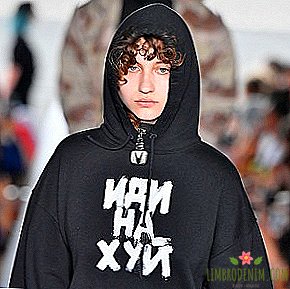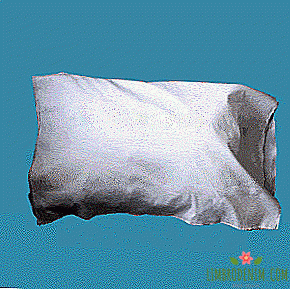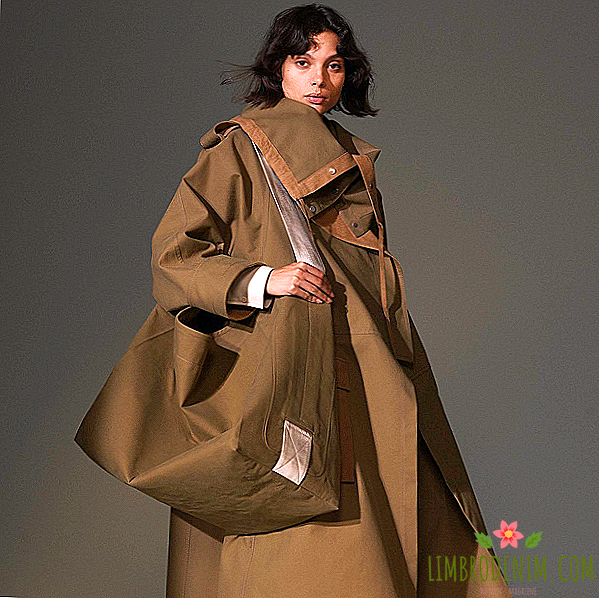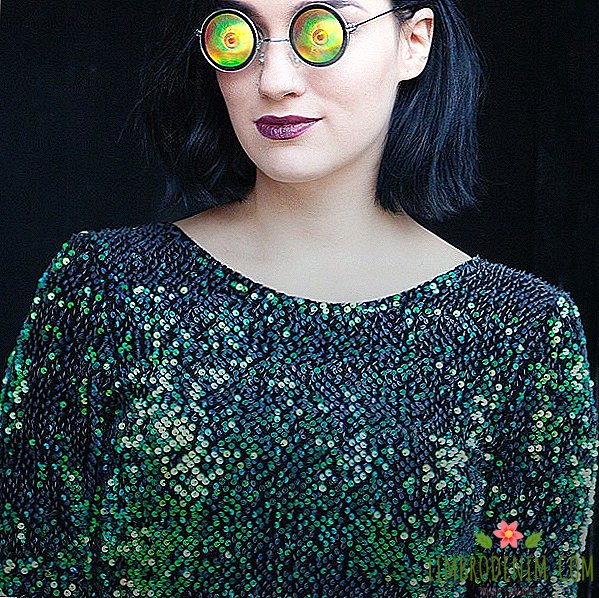"Full demnization": Journalists, buyers and stylists about the new collection of Vetements
show of the spring-summer collection Vetements, which took place the day before yesterday in Paris, quite competed with the most emotional matches World Cup football. Demna Gvasalia - a designer who changes the usual rules of the game: the combined women’s and men’s show was held on the first day of a couture week. The venue - the industrial district of Paris, an improvised banquet hall under the bridge - was itself a gesture. Further more.
The Vetements collection is a blend of the incompatible. Pavloposadsky shawls, portraits of Viktor Tsoi, inscriptions in Georgian and Russian (including provocative "go to x **"), neon colors, masks, hiding faces, chokers and shoes with spikes, a romantic floral print. Upon closer inspection, the entire collection turns out to be a political statement. On the clothes are Russian, Ukrainian and Georgian flags, and the starting point of the collection was the Georgian-Abkhaz conflict of 1992-1993 (the designer’s family is from Sukhumi) and the designer’s childhood experiences associated with it. After the show, it was announced that each item in the collection has a unique barcode that refers to the Wikipedia page telling about the war. We asked representatives of the fashion industry, with what feelings they met the new Vetements collection.
 A very beautiful place was chosen for the show: open space under a long bridge, instead of a podium - white wedding tables. The location and setup looked like an old and very good movie. I was absolutely sure in advance that the show would be great, but it was a shock for me, in a very good way.
A very beautiful place was chosen for the show: open space under a long bridge, instead of a podium - white wedding tables. The location and setup looked like an old and very good movie. I was absolutely sure in advance that the show would be great, but it was a shock for me, in a very good way.
Five years ago, when I saw the first collection of Vetements, it aroused my admiration. Things were really very beautiful and fresh in terms of ideas, so we made a fairly large purchase, which for us in the case of a young brand was uncharacteristic. Then nobody ordered it in Moscow, and when the collection arrived at the store, not a single Russian media wanted to write about it.
This season, for obvious reasons, many have decided to skip the show and now probably bite their elbows. In this show, the waves of goosebumps were walking through my body, I even had to hold back tears. This is an incredible feeling that professional buyers, believe me, are rarely experienced. Demna achieved a sense of catharsis, this show was a work of art. Mentally, I reviewed this show several times and thought a lot about it.
After the show, I was proud of the Gvasalia brothers, which could be compared with the pride of Russia's victory over Spain (by the way, the show and the end of the match were divided ten minutes). Although our football victory was rather an incredible surprise, and this show confirmed and even surpassed expectations.
The genius of the designer can be seen in the new collection, he finally put an end to the attitude of professionals towards himself, showing that Vetements is stronger than ever. He retained the recognizable aesthetics of the brand, but in the collection appeared chic, close to me as a buyer, who orders artisanal, rare and rather expensive things. Anyone who has missed out on a short life can finally relax, stop wasting energy on Vetements discussions and do their work.
The main hit of the show - hoody with the print "Go to x **" - is a polysemantic designer's statement, addressed to many. Such a thing, by the way, is useful to every citizen of Russia: in my opinion, the slogan is very lame, I like its presence in the language, it is very close to our mentality. I talked on the show with a very famous woman who would like to acquire such hoody, because she felt the power of this expression, but could not afford it because of her active life position. So we will not only order it, but we will help decide to buy it. Well, what else did I like in the collection, customers of the store will see next season.
 To be honest, I am always extremely cautious about collections that broadcast a political or socially important message. On the one hand, fashion today is an important part of culture and media space and cannot stand aside from serious problems. On the other hand, the fashion industry is an enormous business machine aimed at making a profit, and in this system the boundaries between a sincere desire to speak out and a desire for hype are often washed away.
To be honest, I am always extremely cautious about collections that broadcast a political or socially important message. On the one hand, fashion today is an important part of culture and media space and cannot stand aside from serious problems. On the other hand, the fashion industry is an enormous business machine aimed at making a profit, and in this system the boundaries between a sincere desire to speak out and a desire for hype are often washed away.
In the context of Vetements, the use of the Georgian-Abkhaz conflict for me personally looks like the second. Gvasalia says about her collection: “For me, this is an attempt to give young people a voice that they don’t have,” because of the government’s regime, they cannot speak and show what they think; there’s no real freedom in Georgia. I experienced it myself, it was painful period for me, and I want to tell about it. " I don’t presume to judge how strong the experiences of the genocide of Georgians in the territory of Abzakhia are in 1992 are for Demny Gvasalia, but for me the whole story looks like speculation on a topic that is extremely painful for the people. Because Vetements is still not a small conceptual brand, but a brand worn by schoolchildren, Moscow hi-passers and Chinese dandies (not only they, of course, but mostly). That is, the brand has a certain audience, which, it seems, doesn’t matter what historical message carries the Hoodie they bought with the inscription in Georgian (just as they didn’t care much for Cyrillic writing). For them, this is just a fashionable clothes of a fashion brand, for Gvasalia, the theme stated in the collection and the accompanying launch of the application, it seems to me, is an attempt to score points from the fashion public, who are fed up with seeing the same design from season to season.
I think that fashion should speak on sharp topics, but it should do it delicately and not turn everything into a pursuit of HYIP. In my telegram channel, I cited the example of the famous 1995 Highland Rape Alexander McQueen show: contrary to popular belief, he was not about violence against women, but about England’s bloody attempts to conquer Scotland. Or another example: in the Ashash Spring-Summer 2017 finale, Ashish Gupta bowed out in a long sleeve with the words "Immigrant", it was his reaction to Brexit, who toughened the position of migrants. The thing attracted so much attention that the designer had to make a batch for sale. As for Vetements, I am very curious to hear the opinion of the Georgians themselves about the collection: what is a story for them a reason for pride or a feyspalm?
It is clear that Demna excites the immature minds of young Georgian designers. I even wanted to somehow make the comic material "Who is the next Demna?" and choose from the collections of Georgian brands things that copy Vetements and Balenciaga. Some designers have changed the whole concept of their brands in the name of Demny. And nobody needs it, except the designers themselves. There is a high interest in Georgian fashion now - young designers just need to skip the cream. At the Pitti Uomo exhibition, Georgia became a “invited nation” literally in June. Demna really cut a window to Europe and paved the way for them, designers understand that. Gratitude from the Georgian audience too. But we talked a lot with Sophia Chkonia, the founder of MBFWTbilisi, that the complete "demilitation" is destructive, she also criticizes designers for copying.
Personally, I never liked ugly fashion. I didn’t like what Gvasalia did at Vetements, I don’t like his Balenciaga either. But this is the spirit of the time, which he and his brother perfectly captured and exploited. For this they can not be disregarded. So I am proud that he is "our" and that he put everyone in his ears like that. And since the collection someone carries and buys, it means that the star was lit for the one who needed it. Judging by the numbers, it needs a large number of people.
In 1992 I was not so many years old, but I remember everything very clearly. I watched the show and seemed to be reliving this time. I read the articles of respected critics and caught myself thinking that I do not believe them. They were not there in 1992-1993. They have not lived it all. They cannot understand the pain and the depth of the experiences of the person who saw it with his own eyes. How could they not understand Chalayan’s pain when he dedicated the collection to events in Cyprus (although there are always two sides to the conflict, I understand that too).
I'm sure someone will accuse Demna of re-inciting ethnic conflict or of commercially successful provocation. Indeed, do not wake famously. But for the first time in many years (after McQueen's death) I didn’t care what models were wearing. I watched a documentary film. Very accurate and very personal. And yes, behind a robe with the word "x **" I saw a whole plot. Night, beach, war. A family with a small child is trying to get on a boat that is not meant for them, and escape from war where it is calm. And the soldiers (this is precisely the very expression on the robe) drive away those who are not allowed onto it. Directors make a movie that they have a pain. Writers write books about it. Demna did what he can do best - a collection of clothes and shows. He wanted people to see his pain, his experiences.
Probably for many it is another commercial move. I do not argue with that. But the movie, too, is not "in the table" removed. Maybe this is a kind of psychotherapy for him. The Georgians still cannot enter Abkhazia without consequences. I could not even go to a friend's wedding, because they could simply not let me in there. The only thing in the collection shows the pain of one side - Georgia. All these tears on the lost Sukhumi on the jackets are very impressed by the feelings of the Georgian patriots. I do not know what my Abkhaz friends think about this collection, and I will not ask. We do not discuss such topics. Friendship is out of politics.
 I consider myself a fan of the emotional outlook on fashion, while the concepts of Demny Gvasalia seem to me mathematically calculated and do not touch. In addition, I think that the social and political themes shifted to the language of fashion design make it heavier and well received by either those who delve deeply into the essence of the presentation and agree with the author, or those who are not at all interested in the designer’s research work, but just buying things.
I consider myself a fan of the emotional outlook on fashion, while the concepts of Demny Gvasalia seem to me mathematically calculated and do not touch. In addition, I think that the social and political themes shifted to the language of fashion design make it heavier and well received by either those who delve deeply into the essence of the presentation and agree with the author, or those who are not at all interested in the designer’s research work, but just buying things.
In my telegram, I told a funny episode about an Italian student who wore a Gosha Rubchinski shirt and had no idea that it was Gosha Rubchinsky that was written in Cyrillic. One can imagine that the same fate will befall the sweatshirts with coarse slogans from the new Vetements collection: the Chinese will buy them, for example, and take with them on a guided tour of Russia, and then everything may turn out to be either ridiculous or dangerous ( this development). But, as I have already said, the social aspects of the collection, despite their scale and tragedy, fascinate me less than the design - and the design of things Vetements, paradoxically, more interesting "in its pure form", separately from the person and from the styling.
Gvasalia makes dresses well; the trouble is that the dress theme in his collections is fixated on the same volumes and silhouettes with a static shoulder line - apparently, they are selling well - and I would like to see more different models. And, in principle, it is possible even without manifestos.
Cover: Getty Images




